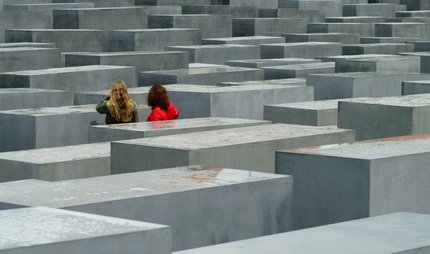
Weißensee Jewish cemetery
In heaven, under the ground
The Jewish Cemetery in Weißensee is the largest in Europe. It is a fascinating place full of history, and full of stories.
An enchanted place, like a maze in a jungle. Overgrown paths with sunken gravestones – silent except for occasional birdsong. Shady trees over the graves and columns and monumental mausoleums. A place full of history and a place full of stories. The Jüdischer Friedhof Weißensee is the biggest Jewish cemetery in Europe. The large site is bedecked with trees that make it look like something out of a fairy tale. There are more than 100,000 graves in the cemetery.
It is the final resting place of many well-known Berliners, including the painter Lesser Ury, the composer Louis Lewandowski, the department store founder Oscar Tietz, and the publishers Samuel Fischer and Rudolf Mosse.
History of the cemetery
In 1880, the Jewish community in Berlin established the cemetery in Weißensee because the existing one in Schönhauser Allee had run out of space. As well as simple graves, there were also magnificent mausoleums, a sign of the new-found self-confidence among Berlin’s assimilated Jews. Under the Nazis, some Jews hid from persecution in the mausoleums on the sprawling site. Jews who had been living illegally in Berlin were secretly buried at the cemetery.
After the war, the Jewish community in Berlin was divided. East Berlin only had a small Jewish community and it was not until the 1970s that the East Berlin parliament designated the cemetery a cultural and historical memorial. There were plans to build an elevated highway over it, until Erich Honecker was persuaded to stop them by Heinz Galinski, the chairman of the Jewish congregation in West Berlin.
Restoration work has begun on the site in recent years.
Memorials
Just behind the main entrance, a memorial in the courtyard commemorates the victims of the Shoah. Inside a circle stands a memorial stone with an inscription that translates as “Remember forever what happened to us. Dedicated to the memory of our murdered brothers and sisters 1933 – 1945 and to the living, who shall fulfil the legacy of the dead. – The Jewish Community of Berlin”. The circle around the memorial stone contains slabs inscribed with the names of the concentration and extermination camps.
The cemetery also contains an urn field where the ashes of people who died in the concentration camps are buried. Gravestones commemorate the dead who have no grave of their own. Behind it is the monument honouring Jewish soldiers who fell in the first world war. A plaque by the graves of honour commemorates Herbert Baum and his group of anti-Fascist resistance fighters.
The film Im Himmel, unter der Erde (In Heaven, Under The Ground) directed by Britta Wauer is an affectionate and informative account of the cemetery and the people who made it what it is.
Digital guide
A digital guide, which you can call up in English or German using a QR code, tells you the story of the cemetery, the graves and the people buried there. You can also find information at www.juedische-friedhoefe-berlin.de. The guide includes the Jewish cemeteries in Große Hamburger Straße, Schönhauser Allee and Weißensee.
Please note that men may not go bare-headed. Kippot can be borrowed at the entrance.
Weißensee
Weißensee is an increasingly popular neighbourhood: young families, creative people and retired people appreciate the green surroundings complete with bathing beach. Take a stroll through the area and have a bite to eat at one of the newly opened cafés.
Find out more about the city’s neighbourhoods with our Going Local Berlin app.
| peak saison | Mon - Thu | 7.30 am - 5 pm |
| Fri | 7.30 am - 2.30 pm | |
| Sun | 8.00 am - 5 pm | |
| off-saison | Mon - Thu | 7.30 am - 4 pm |
| Fri | 7.30 am - 2.30 pm | |
| Sun | 8.00 am - 4 pm |
Saturdays (Sabbath) and holidays closed. Headdress required



